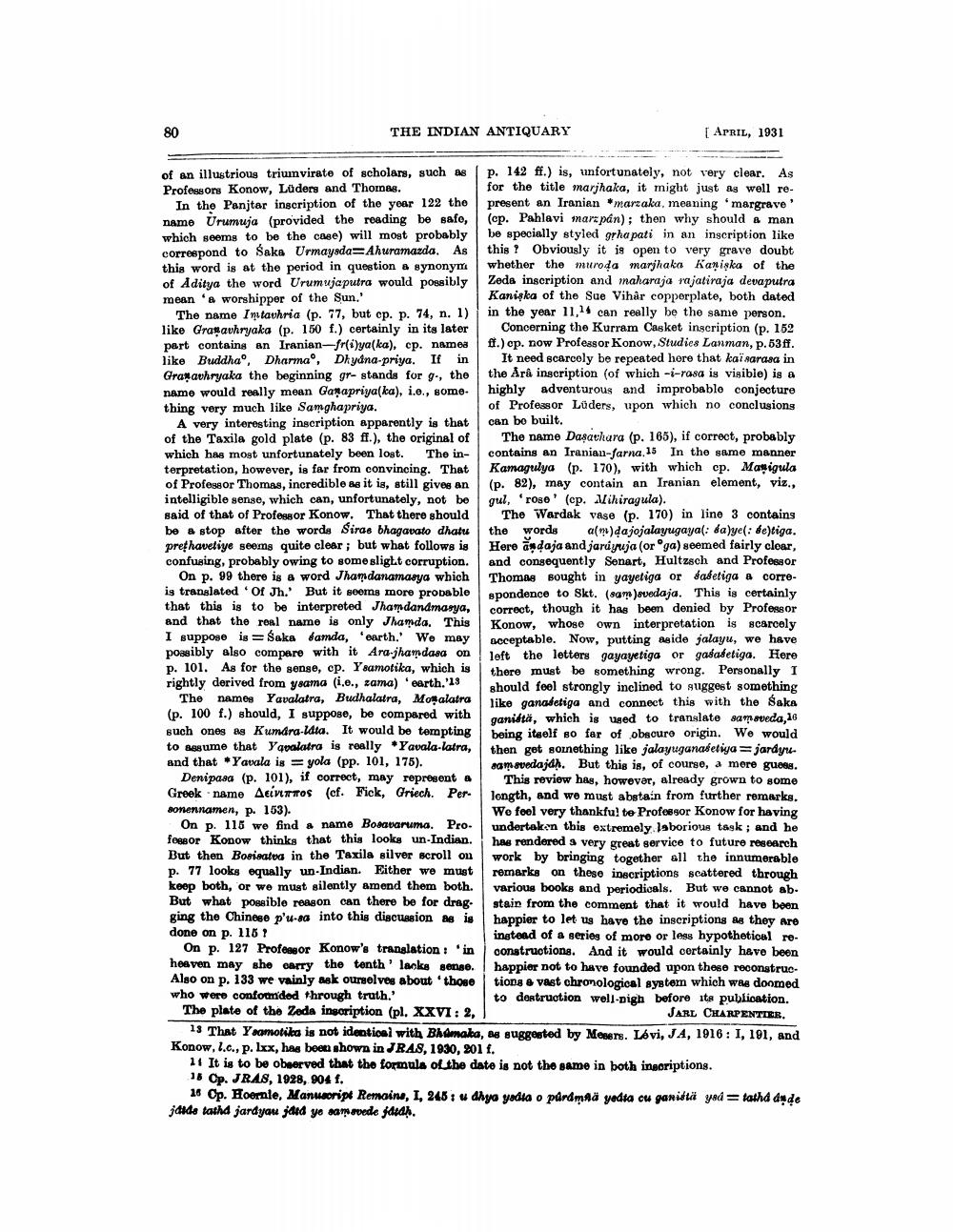________________
THE INDIAN ANTIQUARY
[ Arril, 1931
of an illustrious triumvirate of scholars, such as p. 142 ff.) is, unfortunately, not very clear. As Professors Konow, Luders and Thomas
for the title marjhaka, it might just as well reIn the Panjtar inscription of the year 122 the present an Iranian *marzaka, meaning 'margrave' name Urumuja (provided the reading be safo, (cp. Pahlavi marzpán); then why should & man which seems to be the case) will most probably be specially styled grha pati in an inscription like correspond to Saka Urmayada=Ahuramazda. As this? Obviously it is open to very grave doubt this word is at the period in question & synonym whether the muroda marjhako Kaniska of the of Aditya the word Urumujaputra would possibly Zoda inscription and maharaja rajatiraja deva putra mean's worshipper of the Sun.'
Kaniska of the Sue Vihår copperplate, both dated The name In tauhria (p. 77, but op. p. 74, n. 1) in the year 11,1% can really be the same person. like Grallavhryaka (p. 150 f.) certainly in its later Concerning the Kurram Casket inscription (p. 152 part contains an Iranian-fr(i)ya(ka), cp. names ff.) op. now Professor Konow, Studies Lanman, p.53ff. like Buddha, Dharma, Dkydna-priya. If in It need scarcely be repeated hore that kai narasa in Graxavhryaka the beginning gr- stands for g, the the Arà inscription (of which -i-rasa is visible) is a name would really mean Ganapriya(ka), i.e., some. highly adventurous and improbablo conjecture thing very much like Samghapriya.
of Professor Lüders, upon which no conclusions A very interesting inscription apparently is that can be built. of the Taxila gold plate (p. 83 ff.), the original of the name Dagathara (p. 165), if correct, probably which has most unfortunately been lost. The in- contains an Iranian-farna 15 In the same manner terpretation, however, is far from convincing. That Kamagrılya (p. 170), with which cp. Magigula of Professor Thomas, incredible as it is, still gives an (p. 82), may contain an Iranian element, viz., intelligible sense, which can, unfortunately, not be gul, rose' (cp. Vihiragula). said of that of Professor Konow. That there should The Wardak vase (p. 170) in line 3 contains be & stop after the words Siras bhagavato dhatus the words am)da jojalayugayal: da)ye(: de)tiga. prethaveliye seems quite clear, but what follows is Here andaja and jarúyuja (oroga) seemed fairly clear, confusing, probably owing to some slight corruption. and consequently Senart, Hultzsch and Professor
On p. 99 there is a word Jhamdanamasya which Thomae Bought in yayetiga or safetiga a correis translated Of Jh.' But it seems more probable spondence to Skt. (sam) svedaja. This is certainly that this is to be interpreted Jhamdandmasya, correct, though it has been denied by Professor and that the real name is only Jhamda. This Konow, whose own interpretation is scarcely I suppose is = Saka damda, 'earth. We may acceptable. Now, putting aside jalayu, we have possibly also compare with it Ara jhamdasa on
Ara hampaasa on left the letters gayayetiga or gasafetiga. Here p. 101. As for the senge, cp. Ysamotika, which is there must be something wrong. Personally I rightly derived from ysama (i.e., zama) earth.'13
should feel strongly inclined to suggest something The names Yavalatra, Budhalatra, Mollalatra
like ganadetiga and connect this with the Saka (p. 100 f.) should, I suppose, be compared with
ganida, which is used to translate sampoveda,16 such ones as Kumdra-dia. It would be tempting being itself so far of obscuro origin. We would to masume that Yavalatra is really Yavala-latra, then get soinething like jalayuganasetiya jardyrıand that Yavala is = yola (pp. 101, 175).
aamsvedajah. But this is, of course, a mere guese. Denipasa (p. 101), if correct, may representa This review has, however, already grown to some Greek name Aci TTOS (cf. Fick, Griech. Per
length, and we must abstain from further remarks. sonennamen, p. 153).
Wo fool very thankful te Professor Konow for having On p. 116 we find a name Bosavaruma. Pro- undertaken this extremely laborious task; and he fogsor Konow thinks that this looks un-Indian.
has rendered a very great service to future research But then Bosisates in the Taxila silver scroll on work by bringing together all the innumerable p. 77 looks equally un-Indian. Either we must remarks on these inscriptions scattered through koop both, or we must silently amend them both.
various books and periodicals. But we cannot ab. But what possible reason can there be for drag. stain from the comment that it would have been ging the Chinese p'u-sa into this discussion as is happier to let us have the inscriptions as they are done on p. 116 ?
instead of a series of more or less hypothetical reOn p. 127 Professor Konow's translation : 'in constructions. And it would cortainly have been heaven may she carry the tenth' lacks sense. happier not to have founded upon these reconstruc Also on p. 133 we vainly ask ourselves about 'those tions a vast chronological system which was doomed who were confonded through truth.'
to destruction well-nigh before its publication. The plate of the Zoda inscription (pl. XXVI: 2,
JARL CHARPENTIER. 13 That Yoamotika is not identical with BA denaka, ag suggested by Mesers. Lovi, J4, 1916: 1, 191, and Konow, 1.c., p. Lxx, has been shown in JRAS, 1930, 201 f.
11 It is to be obrerved that the formula ol the date is not the same in both inscriptions. 16 Op. JRAS, 1928, 904 f.
16 Op. Hoornle, Manuscript Remaine, I, 245 + w dhyo yadia o purdmaa yadta cu ganitta yod=tathd dude jakde tatha jardyau jdid yo sam svede jaadh.




